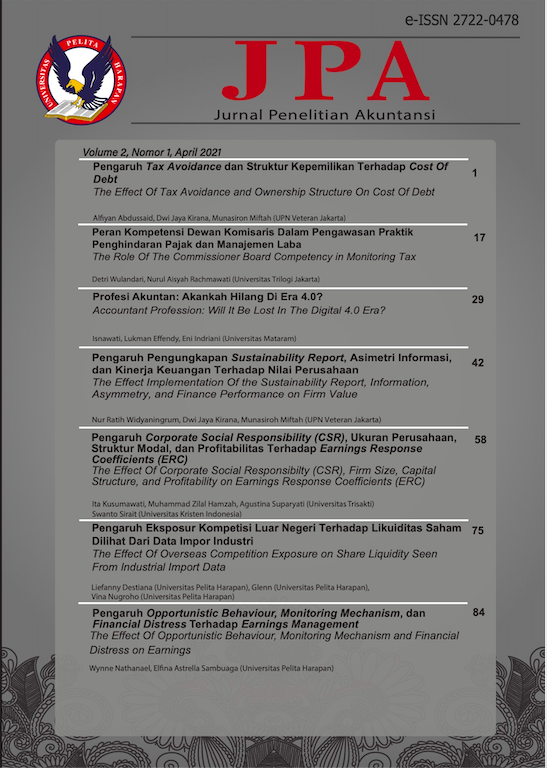PENGARUH OPPORTUNISTIC BEHAVIOUR, MONITORING MECHANISM DAN FINANCIAL DISTRESS TERHADAP EARNINGS MANAGEMENT
Keywords:
earnings management, opportunistic behaviour, monitoring mechanism, financial distressAbstract
This study aims to test the opportunistic behavior, monitoring mechanism and financial distress on earnings management in non-financial companies listed on the Indonesia Stock Exchange (BEI) for the period 2010-2019. The sampling technique used was purposive sampling method. Earnings management can be influenced by various factors, such as profitability,free cash flow,leverage and financial distress.The independent variables to be tested in this study are return on assets, free cashflow,debt ratio and financial distress as measured by the Altman Z-Score.Earnings management as the dependent variable will be measured the value ot its discretionary accruals using the Kothari modal. The research will be regressed with multiple linear regression using SPSS (version 25). The result showed that opportunistic behaviour had a significant positive effect only when measured by the cash flow. Monitoring mechanism as measured by leverage and financial distress has a significance positive effect on earnings managementReferences
Agustia, Y. P., & Suryani, E. (2018). Pengaruh Ukuran Perusahaan, Umur Perusahaan, Leverage, Dan Profitabilitas Terhadap Manajemen Laba (Studi Pada Perusahaan Pertambangan yang Terdaftar di Bursa Efek Indonesia Periode(2014-2016).,10(1),71-82. https://doi.org/10.17509/jaset.v10i1.12571
Altman, E. (1968). Financial Ratios, Discriminant Analysis And The Prediction Of Corporate Bankruptcy. 23(4), 589-609.
Bukit, R. B., & Nasution, F. N. (2015). Employee Diff , Free Cash Flow , Corporate Governance and Earnings Management. 211(September), 585-594. https://doi.org/10.1016/j.sbspro.2015.11.077.
Damayanti, C. R., & Kawedar, W. (2018). Pengaruh Profitabilitas, Mekanisme Pemantauan Dan Financial Distress Terhadap Manajemen Laba. 7, 1-9.
Feldo, F., Rinaningsih, R., & Yuliati, R. (2019). Hubungan Kesulitan Keuangan Dengan Manajemen Laba Pada Perusahaan Yang Terdaftar Di Bursa Efek Indonesia Tahun 2010-2016. Equity, 21(2), 141. https://doi.org/10.34209/equ.v21i2.640
Fitri, N., Noor, M., Mohd, Z., Teck, L., & Mohd, T. (2015). Fraud Motives and Opportunities Factors on Earnings Manipulations. Procedia Economics and Finance, 28(April), 126-135. https://doi.org/10.1016/S2212-5671(15)01091- 6
Ghazali, A. W., Shafie, N. A., & Sanusi, Z. M. (2015). Earnings Management: An Analysis of Opportunistic Behaviour, Monitoring Mechanism and Financial Distress. Procedia Economics and Finance, 28(April), 190-201. https://doi.org/10.1016/s2212-5671(15)01100-4
Gunawan, K., Darmawan, A. S., & Purnamawati, I. G. A. (2015). Pengaruh Ukuran Perusahaan, Profitabilitas, Dan Leverage Terhadap Manajemen Laba Pada Perusahaan Manufaktur Yang Terdaftar Di Bursa Efek Indonesia (BEI). 03(01).
Healy, P. M. (1998). A Review Of The Earnings Management Literature And Its Implications For Standard Setting. November.
Jensen, C., & Meckling, H. (1976). Theory Of The Firm : Managerial Behavior , Agency Costs And Ownership Structure. e. 3, 305-360.
Jensen, M. C. (1986). Agency Costs of Free Cash Flow , Corporate Finance , and Takeovers. 76(2), 323-329.
Kazemian, S., & Sanusi, Z. M. (2015). Earnings Management and Ownership Structure. Procedia Economics and Finance, 31(15), 618-624. https://doi.org/10.1016/s2212-5671(15)01149-1
Kothari, S. P., Leone, A. J., & Wasley, C. E. (2005). Performance matched discretionary accrual measures. 39, 163-197. https://doi.org/10.1016/j.jacceco.2004.11.002
Lehn, K., & Poulsen, A. (1989). Free Cash Flow and Stockholder Gains in Going Private Transactions.
Lestari, S. P., Paramita, P. D., & Pranaditya, A. (2016). Pengaruh Ukuran Perusahaan, Profitabilitas dan likuiditas terhadap Nilai Perusahaan dengan Manajemen Laba sebagai Variabel Intervening (Studi Kasus Pada Perusahaan Manufaktur Sektor Industri Barang Konsumsi Terdaftar di BEI Periode 2012- 2016 ).
Mahawyahrti, T., & Budiasih, G. N. (2017). Asimetri Informasi, Leverage, dan Ukuran Perusahaan pada Manajemen Laba. Jurnal Ilmiah Akuntansi Dan Bisnis, 11(2), 100. https://doi.org/10.24843/jiab.2016.v11.i02.p05
Maulida, H. (2019). Pengaruh Karakteristik Corporate Governance Dan Kualitas Audit Terhadap Manajemen Laba. Jurnal of Accounting, 8(40), 1-15
Sari, A. R. (2017). Pengaruh Perilaku Opportunistik, Mekanisme Pengawasan, Dan Financial Distress Terhadap Manajemen Laba. Diponegoro Journal of Accounting, 6(4), 67-83.
Taufik, M., Suffian, M., Mohd, Z., & Hakim, A. (2015). Manipulation of Earnings : The Pressure of Opportunistic Behavior and Monitoring Mechanisms in Malaysian Shariah-Compliant Companies. Procedia Economics and Finance, 31(15), 213-227. https://doi.org/10.1016/S2212-5671(15)01223-X
Widhiwaluya, D. N. (2016). Analisis determinan earnings management. 5, 1-12
Wiyadi, W., Amalina, N., Trisnawati, R., & Sasongko, N. (2017). Perspektif Positif Praktik Manajemen Laba: Kajian Empiris Pada Perusahaan Manufaktur Go Publik Di Bursa Efek Indonesia. Riset Akuntansi Dan Keuangan Indonesia, 2(1), 49-60. https://doi.org/10.23917/reaksi.v2i1.3682
Published
Issue
Section
License
Authors who publish with this journal agree to the following terms:
1) Authors retain copyright and grant the journal right of first publication with the work simultaneously licensed under a Creative Commons Attribution License (CC-BY-SA 4.0) that allows others to share the work with an acknowledgement of the work's authorship and initial publication in this journal.
2) Authors are able to enter into separate, additional contractual arrangements for the non-exclusive distribution of the journal's published version of the work (e.g., post it to an institutional repository or publish it in a book), with an acknowledgement of its initial publication in this journal.
3) Authors are permitted and encouraged to post their work online (e.g., in institutional repositories or on their website). The final published PDF should be used and bibliographic details that credit the publication in this journal should be included.


